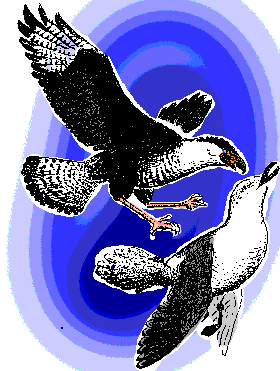Excerpts from Jim Conrad's
Naturalist Newsletter

from the November 9, 2014 Newsletter issued from Río Lagartos, on the Yucatan Peninsula's northern coast (~N21.60°, ~W88.16°), Yucatán state, MÉXICO
CRESTED CARACARA
In southwestern Texas on the Edwards Plateau's southern slope we were at the northern extreme of the Northern Crested Caracara, CARACARA CHERIWAY. Though Caracaras are members of the Falcon Family, the Falconidae, they behave like members of the Vulture Family, the Cathartidae. Around here caracaras are common. Above, a couple appear atop a tree just south of Río Lagartos.
In that picture the bird at the right is an adult while the one on the left, with pink instead of orange skin at the beak base, and a tan throat instead of a white one, is a juvenile. I'm unsure whether the skin color at the base of the beak is a good indication of age; the Oiseaux-Birds.Com website says that "A patch of bare skin around the eyes can change in colour in few seconds, from pink or red-orange, to yellow when it is excited."
Another caracara feeding on something held with a foot while on salt-encrusted ground in the salt flats along the coast about 20kms east of Río Lagartos is shown below:

Around here people call a caracara a Rompe Huesos, which means "bone breaker." They say that caracaras carry bones into the sky, drop them onto hard surfaces, then feed on the marrow when the bones break open. I can't believe that bones fallen from any height will break in a marrow-exposing way, but probably it's true that from time to time you see caracaras dropping bones as they fly away. Usually caracaras turn up feeding on road-kill, competing with ubiquitous Black and Turkey Vultures.
My field guides give the binomial of the Crested Caracara as Caracara plancus instead of the C. cheriway stated above. Lately there's been considerable splitting, lumping and rearranging of this species and its subspecies, and even now the situation doesn't seem settled. Whatever the deal, birds distributed from the US (AZ, FL, LA, NM, TX) south to Panama plus in Cuba now are generally but not always considered Caracara cheriway.
Adapted from Jim Conrad's online book A Birding Trip through Mexico. This excerpt from "The Gulf-Coast Beach at Montepio" in southern coastal Veracruz state
SUDDEN UNEPECTED
 The hours pass with little sense of there ever being anything other than "now." An immature Laughing Gull drifts by just offshore and it hardly registers more than one's turning in bed during a sound sleep.
The hours pass with little sense of there ever being anything other than "now." An immature Laughing Gull drifts by just offshore and it hardly registers more than one's turning in bed during a sound sleep.
But then like a flash of lightning from over the dune-levee behind me a Crested Caracara bolts across the sky right above me and for an instant I see the moment exactly as I sketched at the right.
There is no kill, not even a certain touching of the two birds, and within seconds the caracara is back across the dune-levee and the gull is on down the beach.
I hadn't expected to see a caracara here, and, once I think about it, this is the first gull I've seen since I've been here. What an amazing, unforeseen moment!
And then, the rest of the day, it's more sweet monotony.